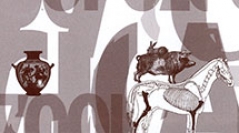

 Anthropozoologica
41 (2) - Pages 37-55
Anthropozoologica
41 (2) - Pages 37-55The large flagstone at Youf Eheket located in the Tassili wan Ahaggar carries representations of nearly two hundred figures. They are human, animal and geometrical representations of the Neolithic and post-Neolithic periods. This initial study divides these works into different groups. There is the large figure of a person subject to the same treatment as the bovine figures which are on its left. There is also the group of large fauna (elephant, rhinoceros, feline and hippopotamus). To these groups other figures of average size and sub-naturalistic style are added. They represent persons and oxen. They form a group with other figures which represent fauna (ostrich, giraffe, rhinoceros, hippopotamus, elephant). Then there are the figures which are more schematic and more invasive. They overlie the first figures and appear to be more recent. The location of this large flagstone in an area which had been swampy would indicate a particular status. The pastoral activity during the Neolithic, and the scarcity of water during the post-Neolithic period may have predisposed humans to visit the flagstone, which could have been a gathering place for humans between the 8th and the 1st millennia BC.
Prehistory, rock art, flagstone, Assali-n-Trakfine, Ti-n-Tarabine, Ahaggar, Sahara, Algeria.